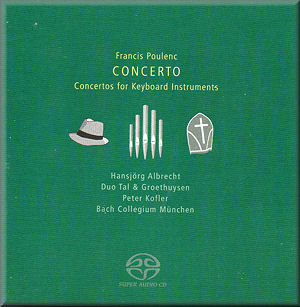 |
 |
|


alternatively
CD:
AmazonUK
AmazonUS
Download: Classicsonline
|
Francis POULENC (1899 - 1963)
Concerto in D minor for two pianos (1932) (arranged for two pianos, organ and
percussion) [19:23]
Concert champêtre (1927/1928) (arranged for harpsichord, organ and percussion)
[25:53]
Organ Concerto in G minor (1938) [21:54]
 Yaara Tal, Andreas Groethuysen
(pianos), Peter Kofler (harpsichord), Babette
Haag (percussion and timpani) Yaara Tal, Andreas Groethuysen
(pianos), Peter Kofler (harpsichord), Babette
Haag (percussion and timpani)
Bach Collegium München/Hansjörg Albrecht (organ and direction)
rec. 27 January 2009, Philharmonie im Gasteig, München (Organ Concerto),
15 and 16 April 2009(Concert champêtre), and 20 and 21 July 2009 (Two Piano
Concerto), Hochschule für Musik und Theater, München DDD
 OEHMS CLASSICS OC637 [67:13] OEHMS CLASSICS OC637 [67:13] 
|
|
|
When I received this disk for review I wasn’t wearing
my glasses so all I read was that three of Poulenc’s
most wonderful creations were on the menu. I thought that this
was
a really good idea and a sensible programme. I am sure that you
can imagine my surprise when I put the disk on to play and heard
not an orchestral accompaniment to the Two Piano Concerto but
an organ and some percussion!
I am at a loss to understand why this disk has been made. I am
even more confused as to why the copyright holder gave permission
for the arrangements. Are they needed? The answer is a most emphatic
no; these arrangements are certainly not needed. You might ask
why are they not needed? The answer is simple. When you have
created something special and important then it can stand on
its own two musical feet without help from others. If you start
to make arrangements of existing material then you had better
have a really good reason for so doing - think of Stokowski’s
marvellous versions of Bach’s organ, and other, works,
which he undertook in order to bring the Master’s works
to a wider public. Stokowski’s transcriptions, like Elgar’s
version of Bach’s Fantasia and Fugue in C minor, BWV
537, shed new light on the originals and enrich our experience
of that music.
So what do these two arrangements do for Poulenc? As far as I
can see and hear, absolutely nothing. One of the joys of the Two
Piano Concerto and the Concert champêtre is
the interplay between soloist and orchestra; the tootle of the
flute, the raucousness of the brass, not to mention the overall
raciness of the music. I indicate one instance to make my point:
after the middle section of the Concert champêtre:
there is a short linking passage with a delightful oboe solo
before the recapitulation starts. This joviality is totally missing
in this version. And that is the point. The humanity of these
lovely works is entirely absent from these versions.
That said, the playing of the pianists Yaara Tal and Andreas
Groethuysen, and harpsichordist Peter Kofler is superb. One would
love to hear them play these works as Poulenc intended, for it
is obvious that they really feel the music.
The Organ Concerto is performed as written and this shows,
if further proof were needed, just what folly the arrangements
are. There is a drawback, however. The string orchestra is far
too small for this music, and the sound is far too thin for such
robust music.
For me, and I suspect for many Poulenc lovers, this disk is a
non-starter for it does a grave disservice to a great composer
- and Poulenc was a great composer in his own way. For the three
works included here, I would recommend that you buy the recordings
on EMI 20th Century Classics series (6955842) where
Poulenc and Fevrier play the Two Piano Concerto (they
premiered it), Maurice Duruflé plays the Organ Concerto and
Gabriel Tacchino the Piano Concerto and Aubade.
An altogether better prospect. If you seek a bigger performance
of the Organ Concerto, I have always enjoyed a recording by E
Power Biggs, with Ormandy and the Philadelphians, but this isn’t
available at the moment; it is worth seeking out (CBS (as it
was) MS 6398).
Bob Briggs
|
|

